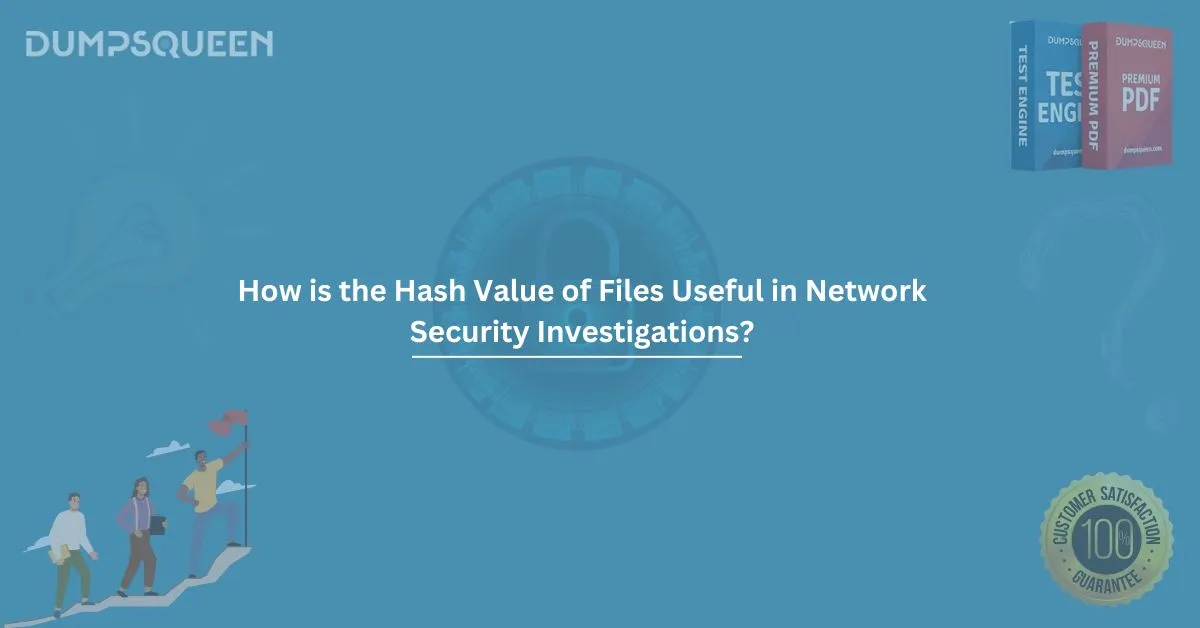Introduction
In the ever-evolving landscape of cybersecurity, where threats loom large and data breaches are rampant, network security professionals depend on various tools and techniques to identify, trace, and resolve malicious activities. One such fundamental concept is the hash value of files. You might have come across it during cybersecurity certifications or while handling forensics tools. But how is the hash value of files useful in network security investigations? This blog by DumpsQueen Official offers a detailed explanation of the role of hash values in maintaining data integrity, tracking intrusions, and aiding digital forensic analysis.
What Is a Hash Value?
A hash value is a fixed-length alphanumeric string generated by a hash function from an input file or message. It acts as a digital fingerprint of that data. Even a minor change in the input data leads to a completely different hash value. Common hashing algorithms include:
- MD5 (Message Digest 5)
- SHA-1 (Secure Hash Algorithm 1)
- SHA-256
These algorithms are one-way functions, meaning you can’t reverse-engineer the original input from the hash. In network security investigations, this property makes them immensely useful.
Why Hash Values Matter in Network Security Investigations
Let’s explore how is the hash value of files useful in network security investigations from multiple angles:
1. File Integrity Verification
Hash values are crucial for verifying file integrity. When a file is transferred across a network, attackers may attempt to inject malicious code. Investigators compare the original hash value (usually provided by the source or vendor) with the current hash value of the received file. If they differ, the file has been tampered with.
2. Malware Detection and Identification
Security experts use hash values to identify known malware. Threat intelligence databases like VirusTotal maintain repositories of malware hashes. When suspicious files are detected, investigators compute their hash and search for matches in these databases. A match instantly flags the file as malicious.
3. Chain of Custody and Digital Forensics
During a cybercrime investigation, maintaining a solid chain of custody is vital. Hashing ensures that digital evidence hasn’t been altered. Before and after every copy or transfer, investigators hash the files to confirm their authenticity. This method supports the legal admissibility of evidence in court.
4. Monitoring File Changes in Real-Time
Organizations implement File Integrity Monitoring (FIM) systems. These tools monitor critical system files by regularly calculating and comparing their hash values. Any unauthorized modification raises a red flag and can prompt immediate investigation.
5. Tracking Data Exfiltration
In cases of data breaches, analysts might check hash values of leaked or suspicious files against internal records. Matching hashes can confirm that sensitive data was indeed exfiltrated, helping in damage assessment and legal proceedings.
6. Intrusion Detection and Incident Response
Intrusion Detection Systems (IDS) and Security Information and Event Management (SIEM) tools rely on hash values to spot threats. When unusual files are found during an incident response, their hash values are checked against threat feeds to speed up decision-making.
Real-World Application Examples
Case 1: WannaCry Ransomware
During the WannaCry ransomware attack, investigators used SHA-256 hash values to identify and catalog malicious files associated with the attack. These hashes were distributed globally to help cybersecurity teams detect infections and mitigate spread.
Case 2: SolarWinds Supply Chain Attack
In the infamous SolarWinds breach, hash values of altered files were published by analysts. Network admins used these hashes to scan their systems and determine whether they were affected, significantly accelerating the threat-hunting process.
Tools That Use Hash Values in Security Investigations
Numerous tools rely on hash functions for integrity checking and threat detection:
- HashCalc – to generate hash values
- MD5sum / SHA256sum – Linux-based hash calculators
- Autopsy – Forensic tool for comparing file hashes
- Wireshark – Can track file transfers and allow you to hash payloads
- Splunk, QRadar, and ELK Stack – for SIEM analysis
Common Hashing Algorithms in Cybersecurity
|
Algorithm |
Hash Size |
Security Level |
Common Use Cases |
|
MD5 |
128-bit |
Low |
Legacy systems, file checksums |
|
SHA-1 |
160-bit |
Medium (deprecated) |
Certificate verification (older) |
|
SHA-256 |
256-bit |
High |
Modern digital signatures, blockchain |
|
SHA-3 |
Variable |
Very High |
Advanced cryptographic applications |
Limitations of Hash Values in Security
While hash values are powerful, they are not foolproof.
1. Collisions
A hash collision occurs when two different files produce the same hash. Though rare with algorithms like SHA-256, MD5 and SHA-1 are susceptible. Hence, MD5 is no longer recommended for critical security tasks.
2. Encryption vs. Hashing
Some confuse hashing with encryption. Hashing is one-way and non-reversible, while encryption can be reversed with a key. They serve different purposes in security.
3. Dependency on Database Accuracy
For malware detection, hash comparison only works if the hash database is up-to-date. Zero-day malware will have no known hash.
Best Practices for Using Hash Values in Investigations
- Always Use Strong Hash Functions (SHA-256 or higher).
- Maintain a Secure Hash Baseline of Critical System Files.
- Compare Suspicious Hashes with Reputable Threat Databases.
- Integrate Hash Checks into Incident Response Playbooks.
- Train Analysts to Use Tools That Automate Hash Comparisons.
Conclusion
So, how is the hash value of files useful in network security investigations? The answer lies in its unmatched ability to verify data integrity, detect malware, preserve digital evidence, and streamline incident response. For cybersecurity professionals and exam candidates preparing through DumpsQueen Official, understanding and applying hashing techniques is not only beneficial but essential. As the digital landscape grows more complex, mastering concepts like hashing will be the key to protecting and investigating data effectively.
Free Sample Questions
1. What is the primary use of a hash value in file integrity monitoring?
A. Encrypt files
B. Restore deleted data
C. Detect unauthorized changes
D. Increase file size
Correct Answer: C. Detect unauthorized changes
2. Which of the following hashing algorithms is considered most secure for forensic investigation?
A. MD5
B. SHA-1
C. DES
D. SHA-256
Correct Answer: D. SHA-256
3. How do investigators use hash values in malware detection?
A. They reverse-engineer the malware
B. They compare the hash with known malware databases
C. They decrypt the malware using the hash
D. They rename files using the hash value
Correct Answer: B. They compare the hash with known malware databases
4. What problem arises when different files produce the same hash value?
A. Encryption loop
B. Data exfiltration
C. Hash collision
D. Spoofing
Correct Answer: C. Hash collision




